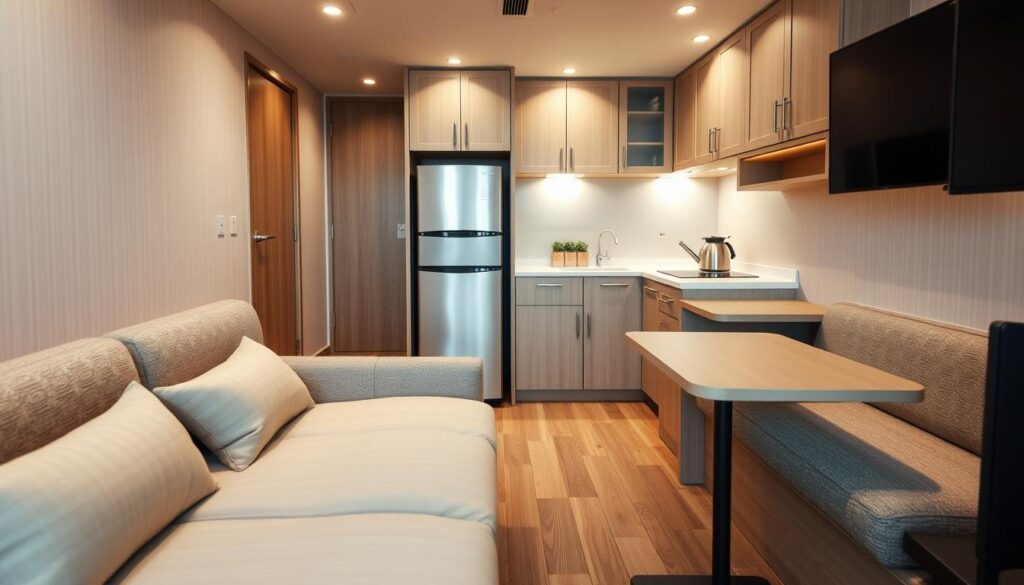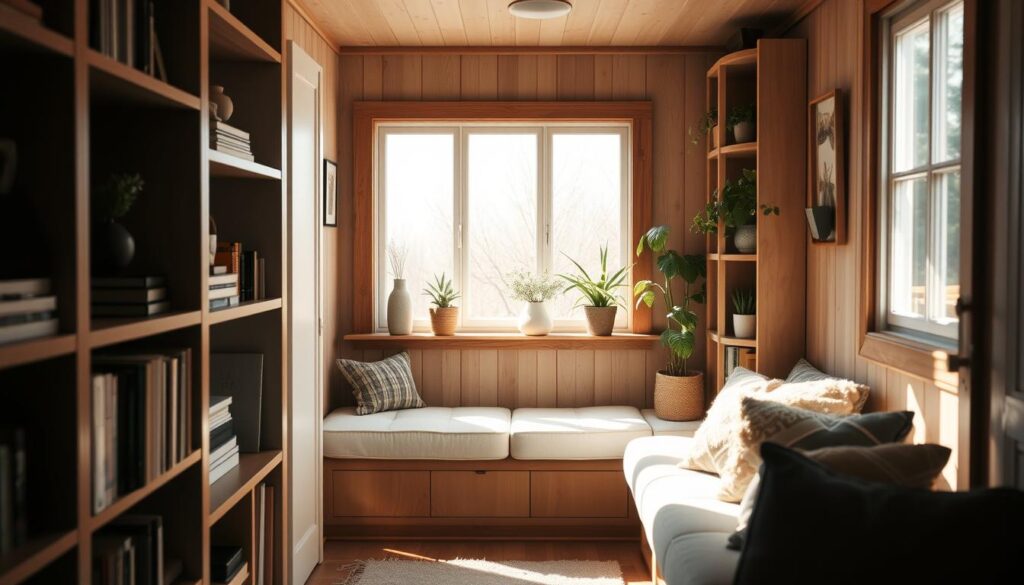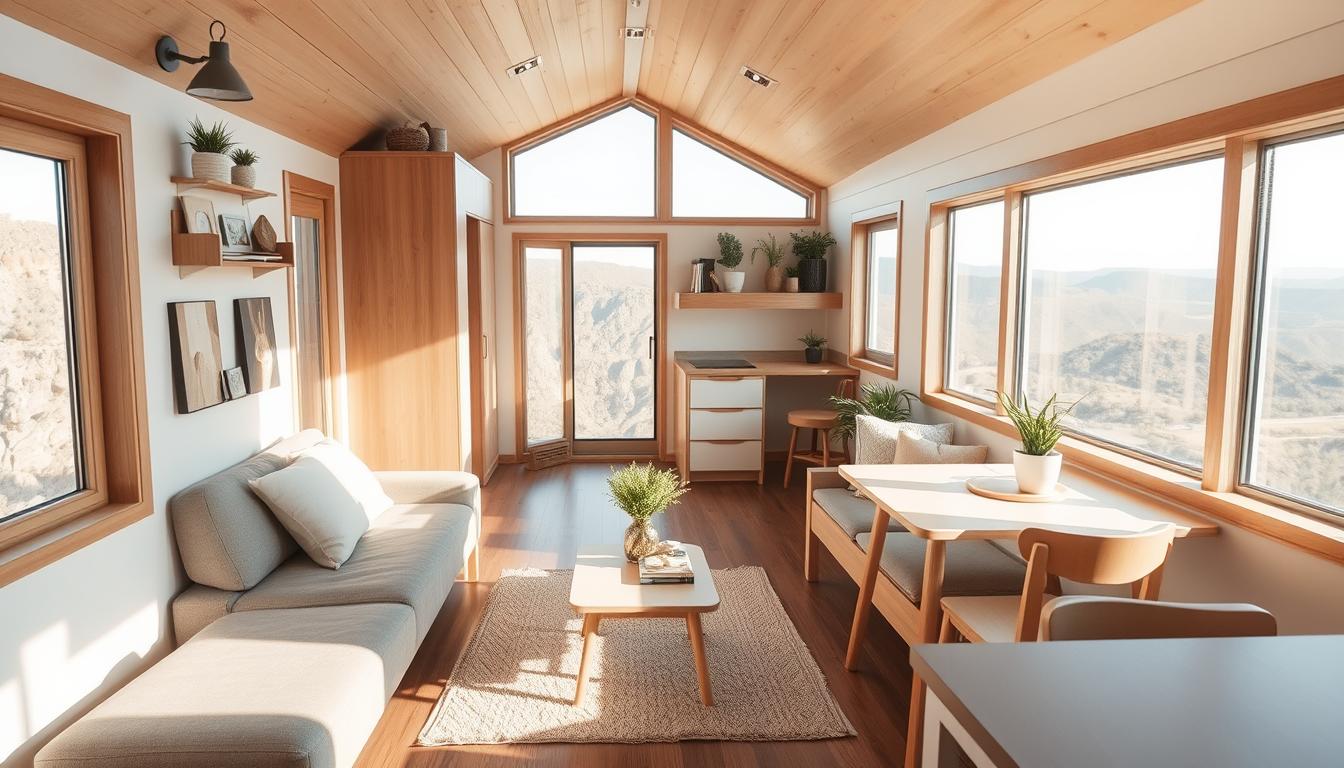The trend of living in tiny homes is growing fast. Thousands of people choose it for its simplicity and efficiency. But, you don’t have to give up style or function just because your space is small.
Creating a beautiful small space needs careful planning and creativity. It’s about using every inch of space well. This way, your tiny home can feel big and welcoming.
We know designing for small spaces can be tough. That’s why we’re sharing our best tips. They’ll help you create a cozy, functional, and beautiful tiny home interior.
Key Takeaways
- Optimize your layout for maximum space efficiency.
- Choose multi-functional furniture pieces.
- Utilize vertical space for storage.
- Select a palette that makes your space feel larger.
- Invest in smart, space-saving technologies.
Understanding Tiny Home Design Principles
The success of a tiny home depends on its design. It focuses on being efficient and using space well. Each part of the home should add to its function and comfort.
We must think outside the box to use space wisely. This means not just getting rid of clutter but making sure every item has a purpose. This way, even small homes can feel big and cozy.
Importance of Space Efficiency
Space efficiency is key in tiny home design. It’s about making the most of what you have. Using wall-mounted items and choosing furniture that doesn’t take up too much room helps a lot.
To save space, try these tips:
- Choose small appliances and fixtures.
- Use wall space for storage.
- Pick furniture that fits the room size.
| Space-Saving Strategy | Description | Benefit |
|---|---|---|
| Compact Appliances | Smaller versions of standard appliances | Saves counter and floor space |
| Wall-Mounted Storage | Storage units fixed to the wall | Keeps floor clear, enhancing the sense of space |
| Proportionate Furniture | Furniture scaled to the room size | Creates a more balanced and spacious feel |
Embracing Multifunctional Furniture
Multifunctional furniture is a big help in tiny home design. Items that do more than one thing can cut down on clutter and make the space more useful. For example, a storage ottoman can be a seat and a place to store things.
Look for furniture that does double duty, like:
- Sofa beds that turn into guest beds.
- Tables with built-in storage.
- Nesting tables that stack up when not in use.
By using these ideas, we can make tiny homes efficient, cozy, and welcoming. The goal is to find a balance between looks and usefulness, making sure every piece adds to the home’s beauty and function.
Choosing the Right Color Palette
In tiny home design, the color palette is more than just looks. It also affects how spacious or cozy your home feels.
Choosing the right colors is key in tiny homes. The right colors can make your home feel bigger and more welcoming. The wrong colors can make it feel small and cramped.
Light Colors for an Open Feel
Light colors are essential in tiny home decor. They make your home feel open and airy. Shades like white, cream, and light gray can make rooms look bigger.
Using light colors on walls, ceilings, and floors helps create a seamless look. For example, a soft white on walls and ceiling can make your room feel taller and more expansive.
“The use of light colors can visually expand a small space, making it feel more welcoming and less confined.”
Accent Colors to Add Personality
While light colors provide a spacious backdrop, accent colors add personality and depth. These colors can be used in furniture, decor, or a bold wall. The goal is to balance them so they enhance the space without overwhelming it.
For a stylish tiny home decor, use a bold accent color that complements the light base colors. For instance, a vibrant blue or green can add a pop of color against a neutral background, creating visual interest.
| Color Scheme | Effect on Space | Ideal Use |
|---|---|---|
| Monochromatic Light | Makes space feel larger | Walls, ceilings, and floors |
| Bold Accent | Adds personality and interest | Furniture, decor, or accent wall |
| Soft Pastels | Creates a cozy, inviting atmosphere | Accent pieces, bedding, or curtains |
To achieve a minimalist living look, balance light base colors with accent colors. Too many bold colors can clutter the space, while too few can make it feel sterile.
By carefully choosing your color palette, you can create a stylish, functional, and welcoming tiny home that reflects your personality.
Maximizing Natural Light
Designing a tiny home interior means using natural light well. It makes your home feel bigger and more welcoming. Natural light changes the whole feel of your space.
Window Placement Strategies
Where you put windows is key for natural light. Place them where they get the most sun. Think about your home’s direction; south-facing windows get more sun than north-facing ones.
Here are some tips for window placement:
- Put windows near the roof or use skylights for more light from above.
- Choose bigger windows or sliding glass doors for more light.
- Position windows for morning and afternoon sun.
Using Mirrors to Enhance Brightness
Mirrors can make your tiny home brighter and more open. By placing mirrors opposite windows, you reflect light and spread it around.
Here are some mirror tips:
- Put a big mirror opposite a window to reflect light.
- Use mirrored furniture or decor for more reflection.
- Try a mirrored wall or section for the best effect.
For more tiny home design tips, check out our page on designing tiny home interiors.
Selecting Furniture that Fits
Choosing the right furniture for your tiny home is key to a cozy and efficient space. We must pick furniture that matches the room’s size to avoid clutter. This ensures we can move around easily.
Size Considerations for Tiny Spaces
When picking furniture for a tiny home, measure the space well. Choose pieces that fit the room’s size. Compact living solutions help use space wisely without losing function. For example, a sofa bed is great for tiny homes because it’s both a seat and a bed.
Foldable and Expandable Options
Choosing foldable and expandable options is smart for tiny homes. These items adjust as needed, saving space when not in use. Think of foldable dining tables, expandable console tables, and nesting coffee tables. They save space and add flexibility to your living area.

By picking furniture that fits your tiny home and using foldable and expandable items, you can create a cozy space. This way, your tiny home will feel spacious and welcoming.
Creating Distinct Living Zones
In tiny homes, it’s key to have different living zones for comfort and function. With less space, it’s vital to set up areas for various activities. This makes your home feel bigger and more organized.
Defining Areas Through Layout
The layout of your tiny home is crucial for setting up different zones. By planning where to put furniture, you can make areas for living, dining, and sleeping. For example, a sofa can act as a divider between the living room and other parts of the home.
Think about your home’s flow when designing. Make sure moving from one zone to another is easy and natural.
Using Rugs and Dividers
Rugs and dividers help separate zones in tiny homes. A rug can mark the edge of a space, like a living room or dining area. Dividers offer a physical barrier between zones.
Pick rugs that match your home’s style, and choose dividers that are easy to move. This lets you change your zones as your needs evolve.
Using these tips, you can make your tiny home both functional and cozy. The goal is to have clear zones without making it feel too closed off.
Storage Solutions for Tiny Homes
In tiny homes, every inch is precious. That’s why storage is key to keeping things tidy and organized.
Built-in Shelving Ideas
Built-in shelving is a smart choice for tiny homes. It offers lots of room for books, decorations, and kitchen items. Plus, it makes your home look great. Custom-built shelves fit perfectly in corners, under stairs, or above furniture.
- Use tall shelves to make the most of vertical space.
- Choose adjustable shelves for items of all sizes.
- Include hidden compartments for valuable or sensitive items.
Creative Under-bed Storage Options
Under-bed storage is a clever idea for tiny homes. It keeps the floor open and makes rooms look bigger. Under-bed storage containers or drawers are perfect for bedding, out-of-season clothes, or luggage.
| Storage Solution | Description | Benefits |
|---|---|---|
| Built-in Shelving | Custom shelves built into walls or corners. | Maximizes vertical space, customizable. |
| Under-bed Storage | Containers or drawers stored under beds. | Keeps floor clear, easy access to stored items. |

By using these storage ideas, tiny home dwellers can enjoy a neat and organized space. Whether it’s built-in shelves or under-bed storage, every bit of space matters.
Personalizing Your Tiny Home
Making your tiny home your own means adding personal touches. It’s about turning a small space into a cozy home that feels like you.
Incorporating Unique Artwork
Artwork can really make your tiny home stand out. Pick pieces that show off your personality or hobbies. Unique artwork can spark conversations and add charm to your space.
- Choose artwork that speaks to you, like paintings, photos, or sculptures.
- Think about your home’s color scheme when picking artwork to match your decor.
- Feel free to mix styles and textures for a unique display.
Adding Personal Touches with Decor
Decor is key to making your tiny home feel like home. It’s about adding personal touches that make it cozy and inviting.
- Use items with sentimental value, like family heirlooms or travel souvenirs.
- Add warmth and texture with throw blankets, pillows, and rugs.
- Show off personal collections or mementos on shelves or in shadow boxes.
By carefully choosing unique artwork and decor, you can make your tiny home beautiful. It will truly reflect your personality and style.
Sustainable Materials in Tiny Home Design
Using sustainable materials in tiny home design is key for eco-friendly living. It’s important to think about the environment when choosing our design. This is crucial in the tiny home lifestyle.
Choosing materials that are good for the planet and last long is important. Eco-friendly furniture choices help us reduce our environmental impact. Furniture made from bamboo or reclaimed wood is a great option. It’s good for the planet and adds a special touch to our homes.
Eco-friendly Furniture Choices
There are many eco-friendly furniture options. For example, furniture from recycled materials or sustainably sourced wood is better for the environment. Some popular choices include:
- Bamboo furniture, which is highly renewable and sustainable.
- Recycled metal furniture, which reduces waste and conserves natural resources.
- Furniture made from sustainably sourced wood, such as FSC-certified wood.
Using Reclaimed Materials
Using reclaimed materials is another way to make tiny homes sustainable. Reclaimed wood adds character and warmth while saving trees. Here are some creative ways to use it:
- Using reclaimed wood for flooring, walls, or ceilings.
- Incorporating reclaimed materials into furniture making.
- Repurposing old doors and windows as decorative elements or functional pieces.
Every choice we make in our tiny homes matters for the environment. Whether it’s eco-friendly furniture or creative use of reclaimed materials, we can make a difference. Every decision helps create a more sustainable living space.
Incorporating Technology in Tiny Homes
Technology is changing how we live in tiny homes, making life easier and greener. As we dive into the tiny home lifestyle, we see how tech can improve our homes.
One big step is adding smart home features. These features make life easier and more efficient.
Smart Home Features for Efficiency
Smart home tech lets us control our homes from afar. We can adjust lights, temperature, and security with ease. For example, smart thermostats learn our preferences and save energy when we’re out.
- Smart lighting systems that adjust based on natural light availability.
- Voice-controlled assistants for hands-free operation.
- Automated security systems with remote monitoring capabilities.
A study by the Smart Home Association shows smart homes use up to 30% less energy. This saves money and helps the planet.
“The future of tiny homes lies in their ability to integrate seamlessly with technology, making them not just smaller, but smarter.”
Energy-efficient Appliances
Using energy-efficient appliances is key in tiny homes. These appliances use less energy but still work well, which is important in small spaces.
| Appliance | Energy Efficiency Benefits | Average Energy Savings |
|---|---|---|
| Smart Refrigerators | Optimized temperature control, reduced energy waste. | 15% |
| Induction Cooktops | Faster cooking times, precise heat control. | 20% |
| Energy Star Rated Dishwashers | Less water and energy consumption. | 25% |
By using these technologies, tiny home dwellers can live more comfortably and sustainably. As tech advances, so will the options for tiny homes, bringing more innovative solutions.
Outdoor Living Spaces in Tiny Home Design
Outdoor living areas can make tiny homes feel bigger. We often look for ways to add more space. A good outdoor area can be like an extra room for relaxing, having fun, or enjoying nature.
Designing a Functional Porch
A porch is a great addition to a tiny home. It connects the inside and outside. Think about what you want it for. Will it be for reading or dining outside? Defining the purpose helps decide what it needs, like seats, lights, and storage.
Choose materials that match your tiny home’s look. For example, if your home looks rustic, use reclaimed wood for the porch. This makes everything look better together.
Maximizing Small Outdoor Areas
Not all tiny homes have big outdoor spaces. But, we can still make small areas inviting. Using vertical gardening is a smart way to use space. It adds plants and privacy.
Choose furniture that’s small but does lots of things. A storage ottoman can be a seat and a place to store things. Here’s a look at different furniture options:
| Furniture Type | Space Requirement | Multifunctionality |
|---|---|---|
| Storage Ottoman | Low | High |
| Outdoor Sofa | Medium | Medium |
| Foldable Table | Low | High |
By picking the right furniture and decor, we can make our outdoor space useful and pretty. This makes living in a tiny home even better.
Tips for Tiny Home Decor
Decorating a tiny home needs careful thought about style and function. We’ve looked at how to make the most of natural light and use eco-friendly materials. It’s key to think about the overall look and feel of your space.
Balancing Style and Function
For tiny home decor, you can choose a minimalist style for simplicity or an eclectic style to show your personality. Start with a neutral base and add pieces that reflect your taste.
Adding Warmth with Textures
Using different textures can make your tiny home cozy and inviting. Mix materials like wood, metal, and fabric. This approach balances your style, whether minimalist or eclectic, for a harmonious look.



